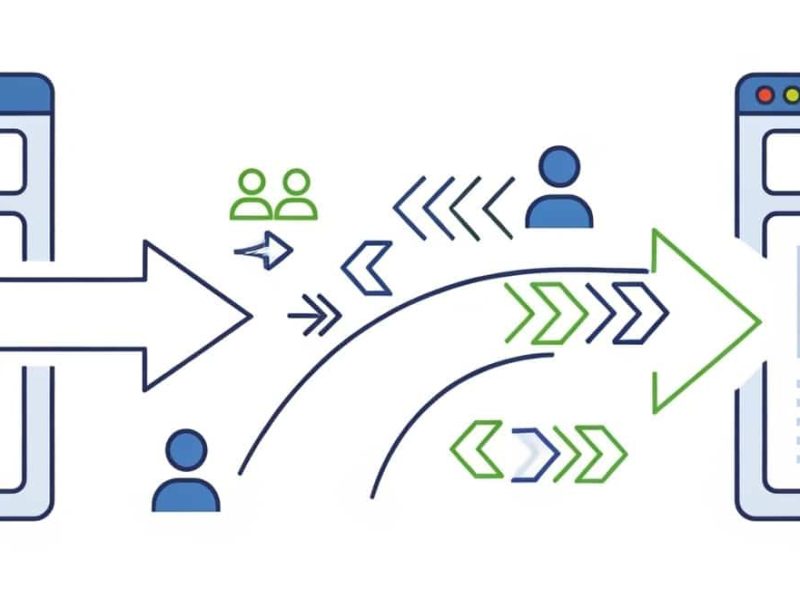The first server response time is a major factor in how quickly your website loads. The user experience (UX) of your website is greatly impacted by server response time, which is simply the speed at which your server reacts to user requests.
We will go over how to determine the causes of a slow server response time in this guide, with a focus on how to shorten the server’s initial response time.
What is server response time?
A measure known as server response time indicates how long it takes for a computer or other device to successfully send a request to the server to load a web page before the device receives a response from the server.
Since many online apps depend on this feedback to work, it is a crucial metric to monitor. In addition, a lengthy server response time will cause the user to wait a long time, either for the web page to load completely or with errors (such as partially loaded images or broken layouts).
As a result, a slow server response time will not only impact load speed but also user visual stability, which is assessed using a different metric known as cumulative layout shift (CLS).
Technically speaking, server response time is also known as Time to First Byte (TTFB) because it represents the amount of time the server needs to take in order to respond to a user request by sending them a single byte.
Reasons You Must Reduce Your Server Response Time
As we’ve already discussed, Google states that users will abandon a website if it takes longer than three seconds to load, and server response time is a major factor in determining how quickly a page loads.
Therefore, a high bounce rate will correspond with a high response time.
Not only does a high bounce rate indicate a bad user experience, but it also lowers your website’s SEO ranking. Of course, Google has its own PageSpeed Insights because page load speed is already a significant SEO ranking factor.
Thus, there are three main reasons why decreasing server response time is important:
- Improved encounter for your guests.
- Lower bounce rate.
- Better SEO performance.
What variables impact load speed and server response time?
What is a decent response time for your website, first of all? What is the ideal response time for a server? Google states that a website has a good response time if its TTFB is less than 200 milliseconds. Thus:
- It’s great if your server responds in less than 100 milliseconds.
- A time between 100 and 200 ms is regarded as good.
- It’s thought that between 200 ms and 1 second is acceptable, but it could be better.
- A second or more is too slow. It might be necessary to shorten server response times.
Your current server response time can be checked with a variety of tools, but the helpful Google Pagespeed Insights (discussed above) is usually sufficient. In the event that your response time is more than 200 milliseconds, the following significant factors could be the cause:

- Hosting Service: A poor web hosting company is frequently the reason for a high server response time, particularly if you are using shared hosting as opposed to dedicated hosting.
- Configurations: The server settings and/or hosting service may not be optimized to their full potential.
- Resources: Your website will load much more slowly if it contains a large number of pages, images, plugins, extensions, and apps, and if they are poorly organized.
- Caching: When caching is done correctly, the web browser can retrieve assets from the local cache rather than repeatedly requesting them from the server. While optimal caching won’t directly shorten server response times, it can dramatically speed up how quickly a page loads.
- Website Traffic: Generally speaking, the server response time will slow down if more users submit requests to your website than it can handle. Visitors might not be able to access your website at all in such circumstances.
Ways to Cut Down on Server Response Time
1. Verify that the hosting service you are using is appropriate.
As we mentioned previously, your hosting service may be to blame for your high server response time, so it’s critical to make sure you’re working with a reliable and top-notch hosting company.
A dedicated hosting service is the best option, but as we all know, they can be highly costly. For smaller websites, shared hosting services can be an affordable option if they are appropriately optimized.

Thus, when deciding between various hosting packages, look for online reviews and suggestions for companies that can consistently maintain a quick server response time.
Using a dedicated server is highly advised if you do have the funds available, as it can greatly improve server response times.
There are other aspects of your hosting provider that you have control over, such as:
- Optimal Caching: For this purpose, you can use a caching plugin if your website is built with WordPress. For ASP.NET website, you can read our previous tutorial about enable caching in ASP.NET.
- CDN: Using a CDN (content delivery network) service can also be a great way to help improve your page speed if you are currently using a shared hosting service with a sub-optimal response time.
2. Cut back on resource sizes and bloat.
If your website is powered by WordPress, be sure to select the best theme. WordPress themes may include different PHP and JavaScript codes; if these codes aren’t optimized, they can significantly slow down your server’s response time. Once more, before installing the theme, look up reviews and the reputation of the creator.
Similarly, to avoid slowing down your server’s response time, if you use plugins (or extensions/add-ons if your website isn’t WordPress-based), make sure to use optimized, unbloated ones.
Additional tips regarding this:
– Minify JavaScript and CSS.
The majority of websites use CSS to control how they function and look. They can consume a substantial amount of server storage, and JavaScript is no different. In order to reduce file size and speed up the processing of CSS and JavaScript codes, minifying basically involves compressing extraneous line breaks, spaces, and characters. Once more, there are a number of WordPress plugins that can assist with this.
– Optimize images and videos.
These days, visual assets like images and videos abound on the majority of websites. Prior to uploading any image or video files to your website, make sure they have all been appropriately compressed and optimized. You can compress files in bulk using a variety of tools, which can greatly aid in lowering file sizes and speeding up server response times.
3. Optimize your database
Enhancing your website’s database optimization can be a very practical method of raising server performance.
Your website will load more slowly and have a larger database as your content (blog posts, comments, etc.) increases.
4. Pre-fetching
Pre-fetching is the process of anticipating and carrying out instructions prior to a user requesting them. For instance, loading certain links or content ahead of time by assuming the user will make more requests later.
Pre-fetching is usually allowed by modern browsers. In general, pre-fetching comes in three flavors:

- Link Pre-Fetching: Link pre-fetching is an option if a page has just one or a few links and you are certain that a user will click on a particular link. This can be used, for instance, to speed up the loading of the shopping cart page after a user has added items, to provide a more stable user experience on the website.
- DNS Pre-Fetching: To speed up loading, domain names are converted into IP address forms beforehand.
- Pre-Rendering: Rendering a portion of the page or all of it beforehand.
Pre-fetching is unquestionably a useful technique for speeding up server response times, but it also wastes resources if you don’t have a good grasp of user behavior.
5. Avoid web fonts
On more recent websites, web fonts, also known as web typography, are becoming more and more common. However, if they aren’t properly optimized, they can increase server load and decrease page rendering speed. This is because web fonts basically increase the number of HTTP requests made to external resources.
As a general rule of thumb, only include character sets that are utilized on the website and only use web font styles that are absolutely necessary. However, for better compression, use the new WOFF 2.0 formats if you must use web fonts.
6. Remove all 404 errors.
Users receive 404 errors when they try to access a page that is no longer available. Even so, these queries use up server resources, and if there are too many of them, your server may become slower.
To find out if your website has 404 error URLs, you can use a number of tools and plugins, such as the useful and free Google Webmaster Tools.

After you’ve located the 404 errors on your website, see how much traffic they bring in. You can leave the links in their current state if they don’t bring in any traffic. If they do, however, still bring in some traffic, you may want to set up redirects and update internal link addresses.
Redirects should only be used when absolutely necessary, though. Redirects would result in more HTTP requests, which would impede the speed of your website.
7. Always update your website
Make sure that you always update your website so Google will always trace your website. Keeping your themes and plugins up to date is crucial if you use WordPress, as patches frequently include features that improve performance. To avoid wasting space, it’s generally advised to only keep the themes and plugins you actually need and remove the rest.
Grow Your Website with ASPHostPortal
As was mentioned, the average user now anticipates a web page to load in under three seconds. A server response time of 200 ms or less will result from this. If you’re going faster than this, visitors to your website will see a higher bounce rate, which usually means less traffic and sales.
Every successful website is built on a strong web hosting infrastructure. Without having to constantly worry about technical failure, it enables you to deliver content and connect with the greatest number of potential customers.
ASPHostPortal has you covered if you’re looking for a dependable hosting solution. Our hosting offers market-leading performance, a 100% uptime guarantee, and first-rate technical support.
We also provide a variety of hosting packages at reasonable prices, including shared, managed, VPS, cloud, and more. To see how simple it can be to host a website online, sign up right away.

Javier is Content Specialist and also .NET developer. He writes helpful guides and articles, assist with other marketing and .NET community work



